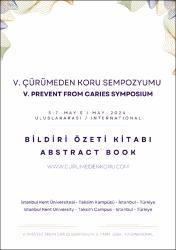Gümüş diamin florür ve potasyum iyodür ile derin çürük tedavisi: Vaka raporu
Citation
Deveci BA, Şahin M, Erden Kayalıdere E, Tağtekin D, Yanıkoğlu F. Gümüş diamin florür ve potasyum iyodür ile derin çürük tedavisi: Vaka raporu. V. Çürümeden Koru Sempozyumu, 2024, 108-109.Abstract
Amaç: Derin çürük lezyonlarında çürük aktivitesini durdurmak ve pulpanın
canlılığını korumak için çeşitli tedavi yöntemleri mevcuttur. Bu olguda, hastanın
derin ve aktif çürük lezyonunun aşamalı olarak uzaklaştırılmasının takiben,
gümüş diamin florür ve potasyum iyodür uygulaması sonrası restoratif prosedür
anlatılmaktadır.
Vaka Raporu: 17 yaşında erkek hastanın 47 numaralı dişinde derin çürük
lezyonu tespit edilmiştir. Hastanın radyografik muayenesinde herhangi bir
periapikal lezyon görülmezken, vitalite testine yanıtı pozitif, perküsyon ve
palpasyon yanıtları ise negatiftir. Rubber dam izolasyonu sonrası dişin
okluzalmorfolojisi diş eti bariyeri ile (Opaldam green, Ultradent) kayıt altına
alınmıştır. Periferal çürüğün temizlenmesinin ardından, kalan çürük lezyonu
üzerine Riva Star (SDI) ajanının ilk basamağı olan gümüş diamin florür ve
sonrasında ikinci basamağı olan potasyum iyodür uygulanmıştır. Yüksek
viskoziteli cam iyonomer restoratif materyal (EQUIA Forte, GC) ile geçici olarak
kapatılmış ve üzerine yüzey örtücü (EQUIA Forte Coat, GC, Japonya)
uygulanmıştır. 4 hafta sonra geçici restorasyon uzaklaştırılıp %37,5 ortofosforik
asit (Gel Etchant, Kerr) ve universal adeziv ajan (G-premio bond, GC)
uygulanıp ışık cihazı (VALO, Ultradent) ile polimerizeedilmiştir. Kavite tabanına
önce akışkan kompozit (Tetric N Flow, Ivoclar) sonrasında pasta kompozit (G ænial, GC) tabakalar halinde yerleştirilmiştir. Son tabaka, okluzal damga ile
şekillendirilip polimerize edilmiştir. Bitim ve cila işlemleri gerçekleştirilerek daimi
kompozit restorasyon tamamlanmıştır.
Bulgular: Restorasyon, 1, 6, ve 12 aylık kontrollerde modifiye United States
Public Health Services (mod-USPHS) kriterlerine göre başarılı bulunmuştur.
Ayrıca 12 aylık kontrolde, dişin elektrikli pulpa testine göre canlılığını koruduğu
gözlenmiştir.
Sonuç: Gümüş diamin florür ve potasyum iyodür uygulaması ile birlikte derin
ve aktif bir çürük lezyonunun aşamalı temizlenmesini takip eden restoratif
prosedür, bu tekniğin çürük aktivitesini önlemedeki ve pulpa canlılığını
korumadaki etkinliğine bir kanıt oluşturmaktadır. Aim: Various treatment modalities are available to stop caries activity and
preserve pulp vitality in deep carious lesions. In this case report, we describe
the restorative procedure after stepwise removal of deep and active carious
lesion followed by silver diamine fluoride and potassium iodide application.
Case Description: A 17-year-old male patient was detected to have a deep
carious lesion on tooth number 47. Radiographic examination of the patient did
not reveal any periapical lesion, while his response to vitality test was positive,
and percussion and palpation responses were negative. After rubber dam
isolation, the occlusal morphology of the tooth was recorded with a gingival
barrier (Opaldam green, Ultradent). After removal of the peripheral caries, the
remaining caries lesion was treated with silver diamine fluoride, the first step of
the Riva Star (SDI) agent, followed by potassium iodide, the second step. A
high viscosity glass ionomer restorative material (EQUIA Forte, GC) and a
surface sealer (EQUIA Forte Coat, GC) were temporarily applied. After 4
weeks, the temporary restoration was removed and 37.5% orthophosphoric
acid (Gel Etchant, Kerr) and universal adhesive agent (G-premio bond, GC)
were applied and polymerized with a light device (VALO, Ultradent). At the
bottom of the cavity, layers of flow composite (Tetric N Flow, Ivoclar) and then
paste composite (G-ænial, GC) were placed. The last layer was shaped with an
occlusal stamp and polymerised. The permanent composite restoration was
completed after finishing and polishing.
Results: The restoration was found to be successful clinically according to the
modified United States Public Health Services criteria at 1,6, and 12 months.
Additionally, the tooth retained its vitality according to the electric pulp test after
12 months.
Conclusion: The restorative procedure following the stepwise removal of a
deep and active carious lesion, along with the application of silver diamine
fluoride and potassium iodide serves as evidence for the effectiveness of the
approach in preventing caries activity and preserving pulp vitality.
Source
V. Çürümeden Koru SempozyumuCollections
- Bildiri Koleksiyonu [14]


















